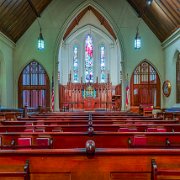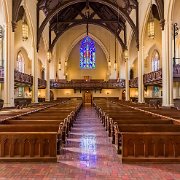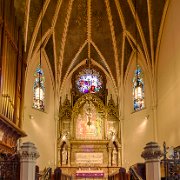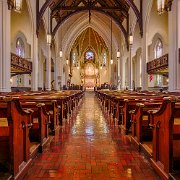
1 The parish of St. John's was organized in Detroit in 1858, primarily due to the efforts of Henry Porter Baldwin, a successful merchant who later became governor of Michigan and a United States senator. Porter purchased and donated the property, which was then on the northern outskirts of Detroit's city limits at the corner of Woodward and High Street (now Interstate 75). He also donated the money to build a rectory and a 150-seat chapel, designed by Albert Jordan, who became a noted church architect in Detroit, and James Anderson.
When the chapel was dedicated in 1859, it was already too small for the burgeoning congregation. A new church was commissioned from Jordan and Anderson and quickly constructed; it was consecrated on December 10, 1861.
When the chapel was dedicated in 1859, it was already too small for the burgeoning congregation. A new church was commissioned from Jordan and Anderson and quickly constructed; it was consecrated on December 10, 1861.

2 The parish of St. John's was organized in Detroit in 1858, primarily due to the efforts of Henry Porter Baldwin, a successful merchant who later became governor of Michigan and a United States senator. Porter purchased and donated the property, which was then on the northern outskirts of Detroit's city limits at the corner of Woodward and High Street (now Interstate 75). He also donated the money to build a rectory and a 150-seat chapel, designed by Albert Jordan, who became a noted church architect in Detroit, and James Anderson.
When the chapel was dedicated in 1859, it was already too small for the burgeoning congregation. A new church was commissioned from Jordan and Anderson and quickly constructed; it was consecrated on December 10, 1861.
When the chapel was dedicated in 1859, it was already too small for the burgeoning congregation. A new church was commissioned from Jordan and Anderson and quickly constructed; it was consecrated on December 10, 1861.

3 The parish of St. John's was organized in Detroit in 1858, primarily due to the efforts of Henry Porter Baldwin, a successful merchant who later became governor of Michigan and a United States senator. Porter purchased and donated the property, which was then on the northern outskirts of Detroit's city limits at the corner of Woodward and High Street (now Interstate 75). He also donated the money to build a rectory and a 150-seat chapel, designed by Albert Jordan, who became a noted church architect in Detroit, and James Anderson.
When the chapel was dedicated in 1859, it was already too small for the burgeoning congregation. A new church was commissioned from Jordan and Anderson and quickly constructed; it was consecrated on December 10, 1861.
When the chapel was dedicated in 1859, it was already too small for the burgeoning congregation. A new church was commissioned from Jordan and Anderson and quickly constructed; it was consecrated on December 10, 1861.

4 The parish of St. John's was organized in Detroit in 1858, primarily due to the efforts of Henry Porter Baldwin, a successful merchant who later became governor of Michigan and a United States senator. Porter purchased and donated the property, which was then on the northern outskirts of Detroit's city limits at the corner of Woodward and High Street (now Interstate 75). He also donated the money to build a rectory and a 150-seat chapel, designed by Albert Jordan, who became a noted church architect in Detroit, and James Anderson.
When the chapel was dedicated in 1859, it was already too small for the burgeoning congregation. A new church was commissioned from Jordan and Anderson and quickly constructed; it was consecrated on December 10, 1861.
When the chapel was dedicated in 1859, it was already too small for the burgeoning congregation. A new church was commissioned from Jordan and Anderson and quickly constructed; it was consecrated on December 10, 1861.

5 The parish of St. John's was organized in Detroit in 1858, primarily due to the efforts of Henry Porter Baldwin, a successful merchant who later became governor of Michigan and a United States senator. Porter purchased and donated the property, which was then on the northern outskirts of Detroit's city limits at the corner of Woodward and High Street (now Interstate 75). He also donated the money to build a rectory and a 150-seat chapel, designed by Albert Jordan, who became a noted church architect in Detroit, and James Anderson.
When the chapel was dedicated in 1859, it was already too small for the burgeoning congregation. A new church was commissioned from Jordan and Anderson and quickly constructed; it was consecrated on December 10, 1861.
When the chapel was dedicated in 1859, it was already too small for the burgeoning congregation. A new church was commissioned from Jordan and Anderson and quickly constructed; it was consecrated on December 10, 1861.
St. John's Episcopal Church